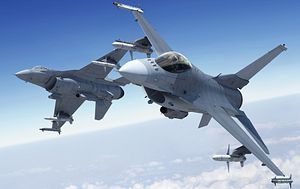The Republic of China Air Force (ROCAF) has begun upgrading its fleet of 144 Lockheed Martin F-16 A/B Fighting Falcon combat aircraft to the latest F-16 configuration, dubbed V for “Viper,” according to local media reports.
The first four ROCAF F-16s are currently undergoing refitting at the state-owned Aerospace Industrial Development Corporation (AIDC), Lockheed Martin’s local partner in Taiwan, based in Taichung. Some of the aircraft will also be flown to the United States for retrofitting.
Total cost for the upgrade of 144 combat aircraft, known as the Phoenix Rising Project, are estimated at around $5.3 billion. According to IHS Defense Weekly, however, the second phase of the upgrade project still requires funding.
“If you review the original congressional notification, the program is valued at $5.3 billion, but the [Taiwanese government] balked at funding the whole thing upfront, so there’s still a second phase of funding required,” U.S.-Taiwan Business Council president Rupert Hammond-Chambers told IHS Jane’s in May 2016.
So far, $3.47 billion has been allocated by the Taiwanese government.
The first four aircraft will be retrofitted by the end of the year. Originally, the first round of upgrades was to consist of ten aircraft. However, delays in software testing in the United States reduced the number to four. Approximately 25 to 28 aircraft will undergo modernization each year until 2023 (some sources claim the middle of 2022.)
In October 2015, the first ROCAF F-16 fighter jet in its V configuration took flight in Fort Worth, Texas. The F-16V configuration is the latest and most advanced F-16 currently in service with air forces across the globe.
All the ROCAF F-16 aircraft will be retrofitted with advanced avionics including a new flight management system, a new active electronically scanned array fire-control radar, an enhanced electronic warfare system, and helmet-mounted display system, among other upgrades.
According to the Lockheed Martin website:
The core of the F-16V configuration is an Active Electronically Scanned Array (AESA) radar, a modern commercial off-the-shelf (COTS)-based avionics subsystem, a large-format, high-resolution display; and a high-volume, high-speed data bus. Operational capabilities are enhanced through a Link-16 Theater Data Link, Sniper Advanced Targeting Pod, advanced weapons, precision GPS navigation, and the Automatic Ground Collision Avoidance System (Auto GCAS).
The new AESA radar will enable ROCAF F-16 fighter jets to detect and engage stealth aircraft including the People’s Liberation Army Air Force’s (PLAAF) Chengdu J-20, according to Taiwan’s Minister of National Defense Feng Shih-kuan. The F-16V will also carry more advanced missiles, including AIM-9X Sidewinders.
According to IHS Jane’s, “based on a 75 percent operational rate as well as maintenance and/or other life cycle support — the ROCAF will have some 79 F-16A/Bs operational at any given time for the duration of the upgrade.”
Taiwan initially wanted to procure 66 new F-16 fighter aircraft from the United States. However, the Obama White House decided against it in 2011 and offered the upgrade instead in order to avoid a major rift with China. The new Trump administration could revisit this decision.
































